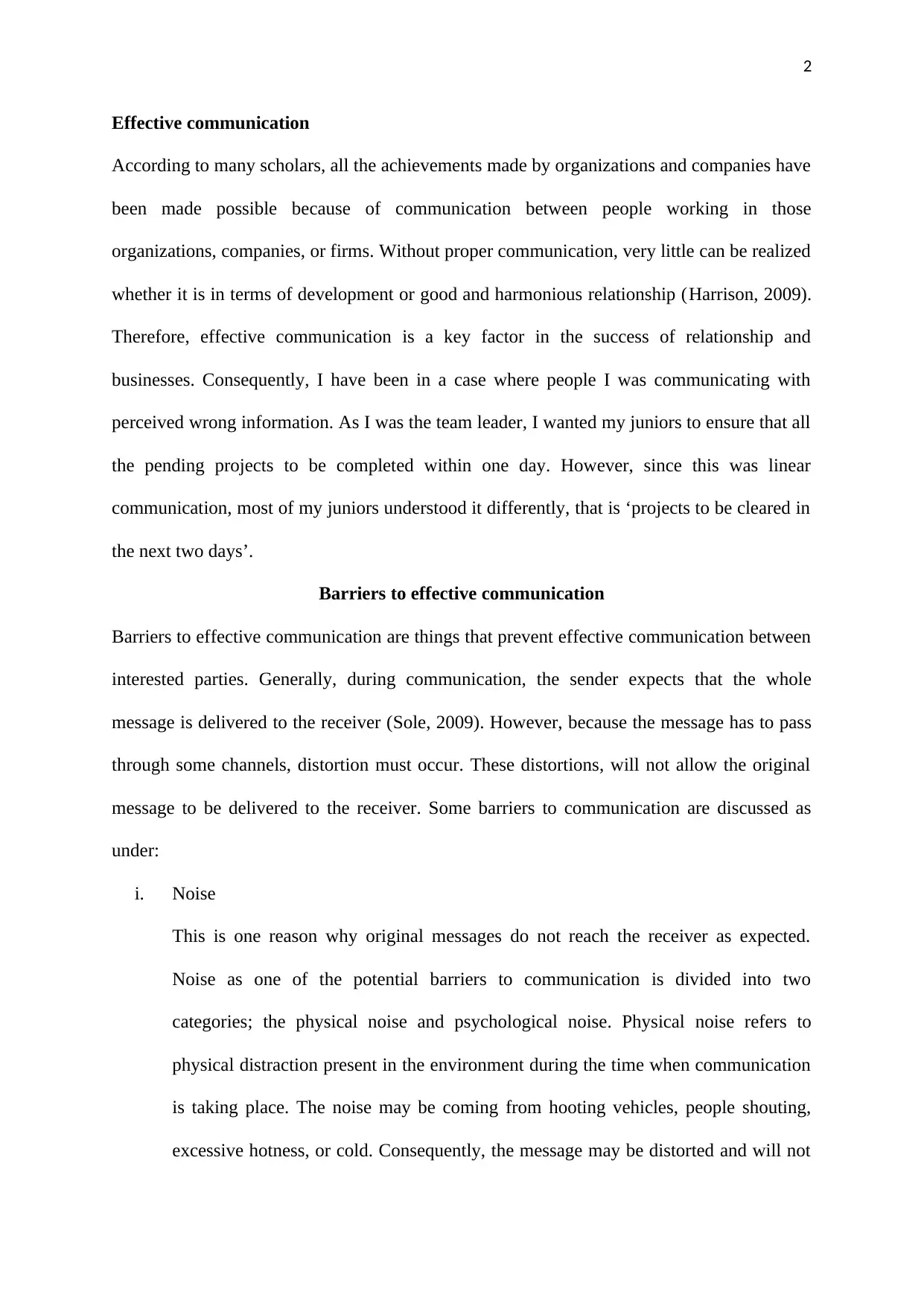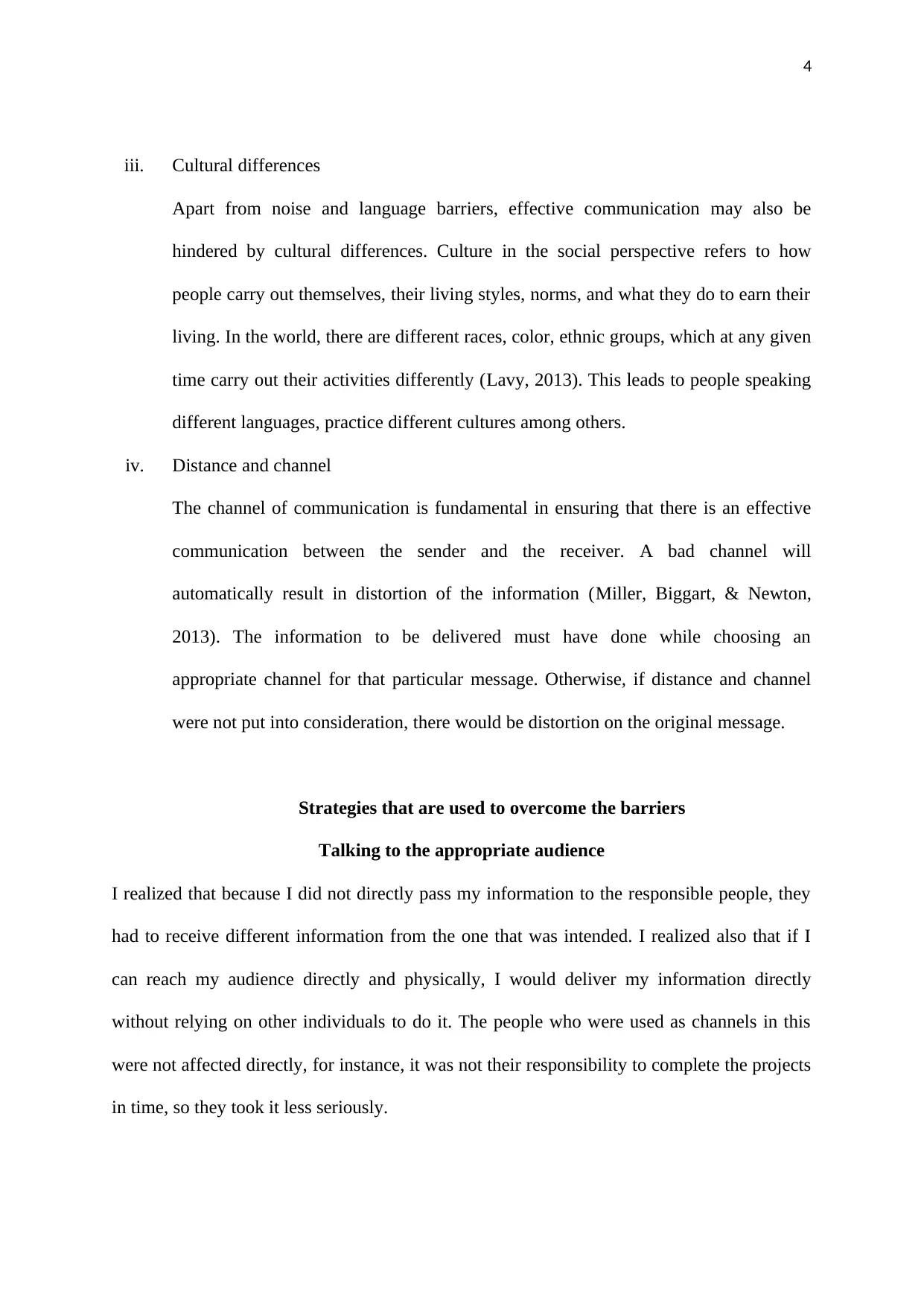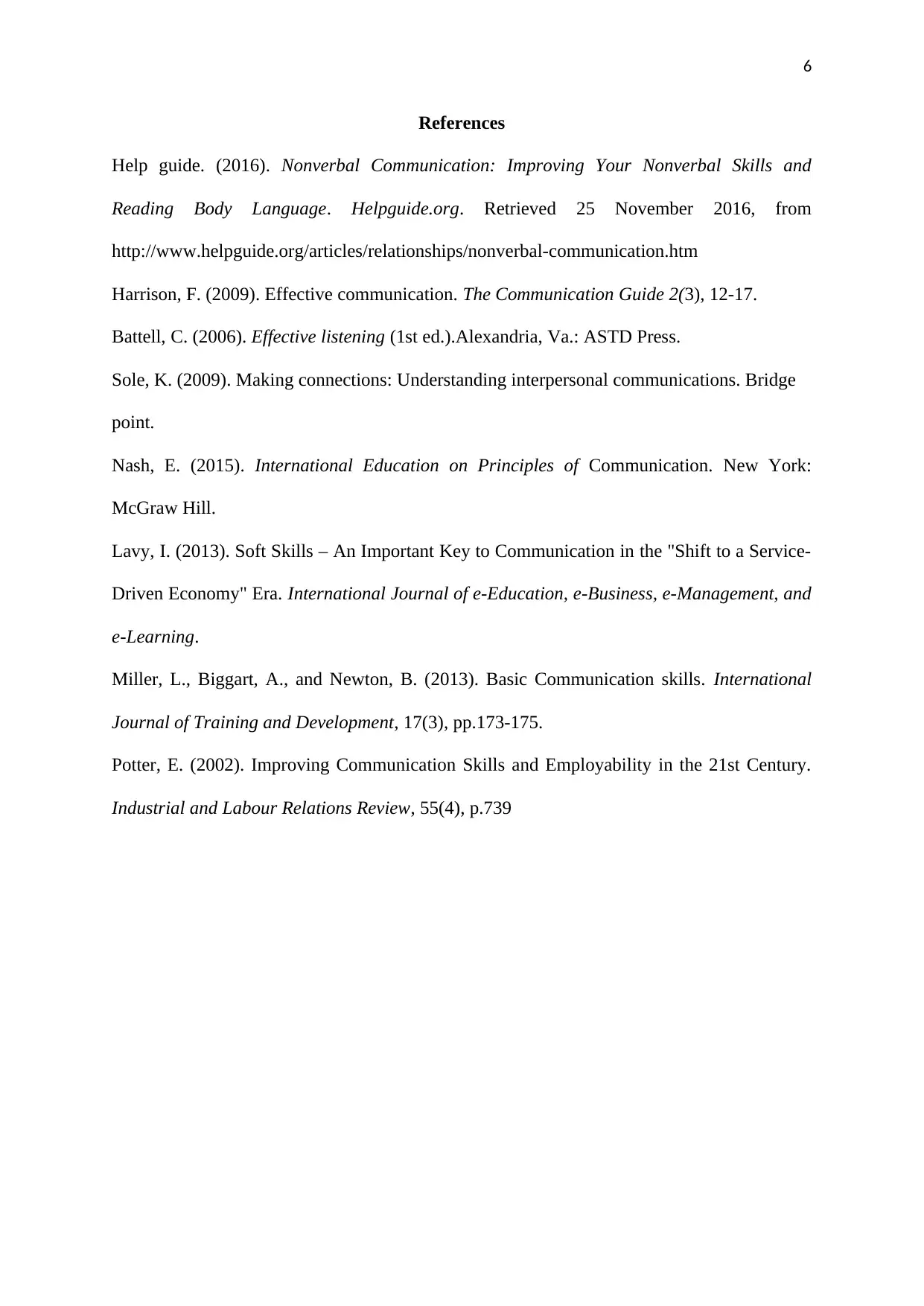Analyzing Barriers to Effective Communication in a Business Setting
VerifiedAdded on 2023/06/13
|6
|1329
|486
Essay
AI Summary
This essay explores the critical role of effective communication in business, highlighting how it underpins organizational success and harmonious relationships. It recounts a personal experience where miscommunication led to a misunderstanding regarding project deadlines, illustrating the impact of linear communication. The essay identifies key barriers to effective communication, including physical and psychological noise, language barriers, cultural differences, and inappropriate communication channels. Strategies to overcome these barriers are discussed, emphasizing the importance of direct communication with the appropriate audience, choosing the right communication channels (such as face-to-face interactions), and using a language that all participants understand. The essay concludes by underscoring the significance of these strategies in ensuring accurate information transfer and preventing misinterpretations in a business environment, with resources available on Desklib.

1
BUSINESS COMMUNICATION
Name of Student
Institutional Affiliation
Name of Tutor
Date
BUSINESS COMMUNICATION
Name of Student
Institutional Affiliation
Name of Tutor
Date
Paraphrase This Document
Need a fresh take? Get an instant paraphrase of this document with our AI Paraphraser

2
Effective communication
According to many scholars, all the achievements made by organizations and companies have
been made possible because of communication between people working in those
organizations, companies, or firms. Without proper communication, very little can be realized
whether it is in terms of development or good and harmonious relationship (Harrison, 2009).
Therefore, effective communication is a key factor in the success of relationship and
businesses. Consequently, I have been in a case where people I was communicating with
perceived wrong information. As I was the team leader, I wanted my juniors to ensure that all
the pending projects to be completed within one day. However, since this was linear
communication, most of my juniors understood it differently, that is ‘projects to be cleared in
the next two days’.
Barriers to effective communication
Barriers to effective communication are things that prevent effective communication between
interested parties. Generally, during communication, the sender expects that the whole
message is delivered to the receiver (Sole, 2009). However, because the message has to pass
through some channels, distortion must occur. These distortions, will not allow the original
message to be delivered to the receiver. Some barriers to communication are discussed as
under:
i. Noise
This is one reason why original messages do not reach the receiver as expected.
Noise as one of the potential barriers to communication is divided into two
categories; the physical noise and psychological noise. Physical noise refers to
physical distraction present in the environment during the time when communication
is taking place. The noise may be coming from hooting vehicles, people shouting,
excessive hotness, or cold. Consequently, the message may be distorted and will not
Effective communication
According to many scholars, all the achievements made by organizations and companies have
been made possible because of communication between people working in those
organizations, companies, or firms. Without proper communication, very little can be realized
whether it is in terms of development or good and harmonious relationship (Harrison, 2009).
Therefore, effective communication is a key factor in the success of relationship and
businesses. Consequently, I have been in a case where people I was communicating with
perceived wrong information. As I was the team leader, I wanted my juniors to ensure that all
the pending projects to be completed within one day. However, since this was linear
communication, most of my juniors understood it differently, that is ‘projects to be cleared in
the next two days’.
Barriers to effective communication
Barriers to effective communication are things that prevent effective communication between
interested parties. Generally, during communication, the sender expects that the whole
message is delivered to the receiver (Sole, 2009). However, because the message has to pass
through some channels, distortion must occur. These distortions, will not allow the original
message to be delivered to the receiver. Some barriers to communication are discussed as
under:
i. Noise
This is one reason why original messages do not reach the receiver as expected.
Noise as one of the potential barriers to communication is divided into two
categories; the physical noise and psychological noise. Physical noise refers to
physical distraction present in the environment during the time when communication
is taking place. The noise may be coming from hooting vehicles, people shouting,
excessive hotness, or cold. Consequently, the message may be distorted and will not

3
be encoded properly. Therefore, physical noise can distort communication at any
level, for instance, it can hinder communication at the sender, receiver, or at the
channel. The second type of noise as a barrier to communication is called
psychological noise. It is usually experienced when the sender or the receiver has
some inbuilt psychological factors, for example, a sender may have problems in
using vocabularies in translating the image into sound such that the receiver can
understand it correctly (Battell, 2006). In this case, the receiver may not get the
meaning of the original content of information intended. Consequently, the receiver
with a perceived mind may further distort the message by encoding it differently.
Since the sender has wrongly interpreted the content of this message from the start,
the receiver will also encode very different thing.
ii. Language barrier
This is one of the most common barriers to effective communication as it is met
frequently. It takes place from the fact that people may speak different languages
including vernacular languages while others may not either understand nor speak a
particular language (Potter, 2002). Consequently, as the sender communicates the
message, the receiver may not understand the information, thus a hindrance to
communication. Similarly, a language may be too hard for the receiver to understand
and this may also lead to the wrong message decoded by the receiver (Help guide,
2016). In some cases, the sender may run short of appropriate language to express his
or her information to the audience, therefore, he or she may decide to use a language
that befits him or her and leave the rest to the receiver to understand and interpret. It
is, therefore, important to choose a language that fits the audience so that
misinterpretation of the information is prevented.
be encoded properly. Therefore, physical noise can distort communication at any
level, for instance, it can hinder communication at the sender, receiver, or at the
channel. The second type of noise as a barrier to communication is called
psychological noise. It is usually experienced when the sender or the receiver has
some inbuilt psychological factors, for example, a sender may have problems in
using vocabularies in translating the image into sound such that the receiver can
understand it correctly (Battell, 2006). In this case, the receiver may not get the
meaning of the original content of information intended. Consequently, the receiver
with a perceived mind may further distort the message by encoding it differently.
Since the sender has wrongly interpreted the content of this message from the start,
the receiver will also encode very different thing.
ii. Language barrier
This is one of the most common barriers to effective communication as it is met
frequently. It takes place from the fact that people may speak different languages
including vernacular languages while others may not either understand nor speak a
particular language (Potter, 2002). Consequently, as the sender communicates the
message, the receiver may not understand the information, thus a hindrance to
communication. Similarly, a language may be too hard for the receiver to understand
and this may also lead to the wrong message decoded by the receiver (Help guide,
2016). In some cases, the sender may run short of appropriate language to express his
or her information to the audience, therefore, he or she may decide to use a language
that befits him or her and leave the rest to the receiver to understand and interpret. It
is, therefore, important to choose a language that fits the audience so that
misinterpretation of the information is prevented.
⊘ This is a preview!⊘
Do you want full access?
Subscribe today to unlock all pages.

Trusted by 1+ million students worldwide

4
iii. Cultural differences
Apart from noise and language barriers, effective communication may also be
hindered by cultural differences. Culture in the social perspective refers to how
people carry out themselves, their living styles, norms, and what they do to earn their
living. In the world, there are different races, color, ethnic groups, which at any given
time carry out their activities differently (Lavy, 2013). This leads to people speaking
different languages, practice different cultures among others.
iv. Distance and channel
The channel of communication is fundamental in ensuring that there is an effective
communication between the sender and the receiver. A bad channel will
automatically result in distortion of the information (Miller, Biggart, & Newton,
2013). The information to be delivered must have done while choosing an
appropriate channel for that particular message. Otherwise, if distance and channel
were not put into consideration, there would be distortion on the original message.
Strategies that are used to overcome the barriers
Talking to the appropriate audience
I realized that because I did not directly pass my information to the responsible people, they
had to receive different information from the one that was intended. I realized also that if I
can reach my audience directly and physically, I would deliver my information directly
without relying on other individuals to do it. The people who were used as channels in this
were not affected directly, for instance, it was not their responsibility to complete the projects
in time, so they took it less seriously.
iii. Cultural differences
Apart from noise and language barriers, effective communication may also be
hindered by cultural differences. Culture in the social perspective refers to how
people carry out themselves, their living styles, norms, and what they do to earn their
living. In the world, there are different races, color, ethnic groups, which at any given
time carry out their activities differently (Lavy, 2013). This leads to people speaking
different languages, practice different cultures among others.
iv. Distance and channel
The channel of communication is fundamental in ensuring that there is an effective
communication between the sender and the receiver. A bad channel will
automatically result in distortion of the information (Miller, Biggart, & Newton,
2013). The information to be delivered must have done while choosing an
appropriate channel for that particular message. Otherwise, if distance and channel
were not put into consideration, there would be distortion on the original message.
Strategies that are used to overcome the barriers
Talking to the appropriate audience
I realized that because I did not directly pass my information to the responsible people, they
had to receive different information from the one that was intended. I realized also that if I
can reach my audience directly and physically, I would deliver my information directly
without relying on other individuals to do it. The people who were used as channels in this
were not affected directly, for instance, it was not their responsibility to complete the projects
in time, so they took it less seriously.
Paraphrase This Document
Need a fresh take? Get an instant paraphrase of this document with our AI Paraphraser

5
Choosing the right channel
The information could have gone a wrong channel to reach the intended people. Therefore, to
overcome the barriers, a sender should choose the right channel to convey the information.
Some of these channels include writing or just talking to the people face-to-face. Face-to-face
is always an effective means because the sender finds time to meet his or her audience
physically and there is room for feedback as well (Nash, 2015).
Use of a language that all the participants understand
As discussed above, the language barrier is one factor that hinders effective communication.
In the modern world, however, people are equipped with different languages, but it is
important to ensure that the language being used to convey the message is one that everybody
will understand so that they would be able to interpret and encode the correct information.
Choosing the right channel
The information could have gone a wrong channel to reach the intended people. Therefore, to
overcome the barriers, a sender should choose the right channel to convey the information.
Some of these channels include writing or just talking to the people face-to-face. Face-to-face
is always an effective means because the sender finds time to meet his or her audience
physically and there is room for feedback as well (Nash, 2015).
Use of a language that all the participants understand
As discussed above, the language barrier is one factor that hinders effective communication.
In the modern world, however, people are equipped with different languages, but it is
important to ensure that the language being used to convey the message is one that everybody
will understand so that they would be able to interpret and encode the correct information.

6
References
Help guide. (2016). Nonverbal Communication: Improving Your Nonverbal Skills and
Reading Body Language. Helpguide.org. Retrieved 25 November 2016, from
http://www.helpguide.org/articles/relationships/nonverbal-communication.htm
Harrison, F. (2009). Effective communication. The Communication Guide 2(3), 12-17.
Battell, C. (2006). Effective listening (1st ed.).Alexandria, Va.: ASTD Press.
Sole, K. (2009). Making connections: Understanding interpersonal communications. Bridge
point.
Nash, E. (2015). International Education on Principles of Communication. New York:
McGraw Hill.
Lavy, I. (2013). Soft Skills – An Important Key to Communication in the "Shift to a Service-
Driven Economy" Era. International Journal of e-Education, e-Business, e-Management, and
e-Learning.
Miller, L., Biggart, A., and Newton, B. (2013). Basic Communication skills. International
Journal of Training and Development, 17(3), pp.173-175.
Potter, E. (2002). Improving Communication Skills and Employability in the 21st Century.
Industrial and Labour Relations Review, 55(4), p.739
References
Help guide. (2016). Nonverbal Communication: Improving Your Nonverbal Skills and
Reading Body Language. Helpguide.org. Retrieved 25 November 2016, from
http://www.helpguide.org/articles/relationships/nonverbal-communication.htm
Harrison, F. (2009). Effective communication. The Communication Guide 2(3), 12-17.
Battell, C. (2006). Effective listening (1st ed.).Alexandria, Va.: ASTD Press.
Sole, K. (2009). Making connections: Understanding interpersonal communications. Bridge
point.
Nash, E. (2015). International Education on Principles of Communication. New York:
McGraw Hill.
Lavy, I. (2013). Soft Skills – An Important Key to Communication in the "Shift to a Service-
Driven Economy" Era. International Journal of e-Education, e-Business, e-Management, and
e-Learning.
Miller, L., Biggart, A., and Newton, B. (2013). Basic Communication skills. International
Journal of Training and Development, 17(3), pp.173-175.
Potter, E. (2002). Improving Communication Skills and Employability in the 21st Century.
Industrial and Labour Relations Review, 55(4), p.739
⊘ This is a preview!⊘
Do you want full access?
Subscribe today to unlock all pages.

Trusted by 1+ million students worldwide
1 out of 6
Related Documents
Your All-in-One AI-Powered Toolkit for Academic Success.
+13062052269
info@desklib.com
Available 24*7 on WhatsApp / Email
![[object Object]](/_next/static/media/star-bottom.7253800d.svg)
Unlock your academic potential
Copyright © 2020–2025 A2Z Services. All Rights Reserved. Developed and managed by ZUCOL.





